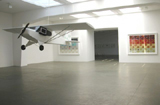'Imagine The Possibilities' - Anila Rubiku
curated by James Putnam
Galleria Alessandro Bagnai, Florence
14 March -
9 May, 2009
Central to Anila Rubiku’s current body of work is her recent residency at ASU Art Museum, Arizona. Here she conceived and produced the two vast wall works composed of 80 individually sewn drawings on leather swatches. In common with many of her other projects she involved members of the local community in the production. After sketching her designs directly onto the leather, she then sewed alongside her team of helpers that included students from the Arizona State University. The work was completed when she returned to Milan and the individual panels were assembled and mounted together in her studio. The mechanisms of travel like the car and the airplane often feature in Rubiku’s work. The exhibition includes an installation with a large model of a Cessna aircraft. Mounted on the plane are two screens with six animations of the sewn leather drawings accompanied by a special sound track. This notion of travel is also conveyed in her large installation entitled ‘Milan-Tokyo: A Round Trip’. This is a completely new presentation of a project originally realized for the Echigo Tsumari Triennial, Japan in 2006. Working with local housewives in Tokamachi (Niigata prefecture) she embroidered 50 individual scenes on linen documenting her journey to Japan. This was also an apt method of connecting her own embroidery to the traditional Japanese textile culture of the region.
Her work is frequently autobiographic and relates to the more philosophical aspects of travel or mind-journeys. A desire to be elsewhere, expectations and hopes and the perception of far away places and people. This is perhaps connected to Rubiku’s relatively nomadic life-style and her need to create a sense of place or fulfill a homing instinct. Recurrent imagery is the iconography of the everyday, depictions of cozy domestic interiors with stylish designer furniture combined with scenes of a sexual nature and the interaction between them. There is an ongoing dialogue between inside and outside with an investigation of the relationship between the body, architecture and the home. Her work also reflects on industrialization, modernization and design for living, while addressing issues of gender, sexuality and their underlying issues in connection to urban domestic life. Rubiku’s work also explores the wider notion embodied in travel of the dialectic between anticipation and reality and how it relates to time. Our experience of the trip is dependent more on the mindset with which we travel than on the destination we travel to and our awareness of why we are on the move. Her delicately sewn figurative drawings and poetic texts reveal her natural curiosity in recording specific details and experiences like her Arizona residency.
This is Anila Rubiku’s first large scale solo exhibition in Italy and includes sewn drawings on paper, leather and linen some of which are made into large sculptural structures and installations. Anila Rubiku was born in Durres, Albania, 1970 and currently lives and works in Milan. She graduated from the Academy of Fine Arts in Tirana, Albania (1994) and from the Academy of Brera, Milan, Italy (2000). Her work is represented internationally in public and private collections and she has exhibited extensively, participating in important biennales and winning several prestigious awards and residencies.
Link:-
http://www.galleriabagnai.it/index.php?file=mostre
|
|
 |